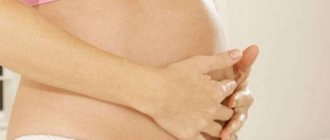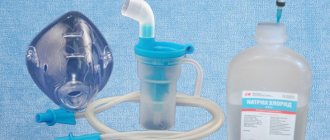Positional drainage during pregnancy
author: doctor Shevcherko N.G.
During pregnancy, at various stages, most women experience health problems. But this rarely leads to a complete contraindication for gymnastics and is usually temporary. Properly selected exercises will help ensure better blood supply to internal organs, mainly the kidneys, and relieve lower back pain. The knee-elbow position, for example, can be classified as positional drainage, as the production and elimination of urine with toxins is enhanced. In addition, by relieving pressure from the pelvic vessels, the outflow through the veins of the lower extremities improves, which helps treat swelling or pastiness of the legs.
First trimester
During the first trimester, the uterus grows moderately and does not yet put pressure on nearby organs. Therefore, you can quite actively engage in sports, except for jumping and risky movements. If you are concerned about early toxicosis, then moderate walking, full sleep, listening to pleasant music are recommended, exercises with static tension, and stretching are selected.
Second and third trimester
During the second and third trimester, the uterus already begins to put pressure on the abdominal region and the bifurcation of the aorta, kidneys, liver, and subsequently the diaphragm tightens. In this case, exercises are indicated in a sitting position and in a knee-elbow position.
Exercises
Start a set of exercises with rhythmic, calm and deep breathing to a good melody for a minute. You can walk in place, raising your knees not high. Sit on the mat and fold your legs in Indian style. Perform turns with the center of your body with bent arms several times. This will improve blood supply to the lungs and uterus. Connecting your feet, spread your knees to the sides and press your hands on them with elastic movements. This way you stretch some ligaments in preparation for childbirth. Exercises to tense the vaginal muscles (as if holding back urination) also stimulate blood circulation, are safe and doable at almost any time.
Take the knee-elbow position more often during the day. During gymnastics, use this starting position for the following exercises. Arch your back, then straighten it parallel to the floor, then bend as low as possible, and lift your head and shoulder girdle up. Then complicate it, perform movements with turns of the head and lateral bending of the body in the same direction.
For the same purposes, it is necessary to turn more often from one side to the other, and if possible, lie down. This relieves pressure from the ureters. There are exercises lying on your side with your legs raised to the side. In this case, the foot should be parallel to the floor, relaxed, and only the calf muscles and lateral thigh muscle groups are tensed. The free hand rests on the side of the floor, the stomach does not tense.
To improve blood flow, it is good to perform movements on the ball, during which you move your legs apart and relax your back muscles. Attend gymnastics for pregnant women with an instructor who will help you create a more specific and tailored lesson plan, taking into account your well-being and your treatment goals.
Basic useful yoga exercises during pregnancy
Butterfly pose for pregnant women
When starting to practice, choose the right time and place for training. First of all, a calm environment and a room that can be ventilated are helpful. Your main goal is to achieve peace and banish negative thoughts from your mind.
Take a comfortable position, relax and calm down, mentally prepare for the start of the practice, feeling your body and the child inside. Do all the exercises that you will perform at a time that is comfortable for you. Usually this is about five breathing cycles, which are inhalation from the diaphragm and a leisurely, gradual exhalation.
Asanas that are recommended to be performed during pregnancy:
- Butterfly pose for pregnant women
You need to sit down, put your feet and heels together, pull them towards your stomach, so that you are comfortable. Place your hands on your feet and relax. Make your back straight, trying to stretch your spine
It is important to feel the back stretching upward and at the same time lowering the buttocks down. At the same time, gradually move your hips apart and try to relax. After this, take three or two breaths, deep enough and rest your hands on the surface in front of you.
Move your neck, shoulders, head a little forward; Elbows, shoulders – relax as much as possible.
Next, you need to take a few deep breaths with your stomach and slowly lean forward. Bend over, feeling our hips relax and move apart
It is extremely important to catch the moment when the buttocks gradually lower down to a feeling of pleasant pleasure. Take two to three slow breaths in and out in this position.
After exiting the butterfly pose, you need to return your arms to your body and stretch, returning to a vertical position.
This position will allow you to increase the flexibility of the pelvis, promoting the proper development of the fetus and facilitating the process of childbirth in the future.
Cat and cow pose for pregnant women
- Cat and cow pose for pregnant women
This pose is considered the main pose for pregnant women. It is usually recommended by obstetricians. To begin, you need to get on all fours. You need to place your knees comfortably. Your palms will be at shoulder level, your fingers should be spread out. The head hangs relaxed. Curl your toes. Slowly tuck your buttocks until you feel tension, light and pleasant, in the lower back. Next, place your palms on the floor and round your back, from the tailbone to the cervical spine. All vertebrae rush towards the ceiling. Take a couple of deep breaths and exhales in this position. Slowly enough, straighten your body back out.
Your stomach should be relaxed and close to the floor. then direct your buttocks towards the ceiling, your back will bend pleasantly. Raise your head as if you wanted to look forward. Direct your breathing mentally towards your lower back.
This pose will give flexibility to the muscles of the back and pelvis and relax the spine. It is recommended for a more comfortable experience of contractions in the future (you will be able to relax, the harm from stress will be minimal).
In the cat pose: why should pregnant women stand on all fours?
The position on all fours (positional drainage) is especially useful for women once their pregnancy has passed the 20-week mark. The growth of the uterus and accompanying changes in the body cause the expectant mother a number of inconveniences:
- Due to mechanical compression of the stomach, acidic contents are refluxed into the esophagus. The mucous membrane becomes irritated and heartburn occurs. Usually this process is prevented by the sphincter, which works on the principle of a valve, but under the influence of progesterone its tone decreases.
- The functioning of the intestine is disrupted, its peristalsis slows down, which leads to constipation, discomfort and bloating.
- Swelling occurs due to changes in water-salt metabolism and an increased amount of fluid.
- The rectum is pressed against the spine and pelvis, venous outflow worsens, which provokes the development of hemorrhoids.
- Due to deterioration of blood circulation due to the growth of the uterus, changes in hormonal balance and blood parameters, varicose veins worsen.
- Back pain appears, especially when walking for a long time. They arise due to a shift in the center of gravity and increased load on this section - the spine and back muscles take on part of the work due to stretching of the abdominal muscles. Increased weight also makes the situation worse. In the presence of diseases of the musculoskeletal system, their exacerbation occurs.
- The urge to urinate becomes more frequent due to compression of the bladder by the growing uterus.
- Disturbances occur in the cardiovascular system due to the increased load on it associated with increased blood flow, increased heart rate and increased body weight. Dizziness appears, blood pressure drops, and the pregnant woman experiences oxygen starvation.
- It becomes difficult to breathe (we recommend reading: why is it hard to breathe during pregnancy?). This symptom is felt by pregnant women in the last stages, since it is associated with the pressure of a highly elevated uterus on the diaphragm.
The knee-elbow position is useful for pathologies such as inflammation of the bladder and kidneys, circulatory disorders, uterine hypertonicity, gestosis and placental insufficiency. This position is especially recommended for breech presentation of the fetus - it helps the baby turn head down.
Pregnant women benefit from doing the cat exercise
Unfortunately, every year there are more and more people who experience pain in the back in one way or another. the reason is physical inactivity (sedentary lifestyle) and scoliosis (curvature of the spine). You can forget about back pain and even improve your posture if you do various exercises. We will talk about one of them in more detail in this article.
Features of the “Cat” exercise
It was originally used in yoga. Now quite common in fitness and physical therapy. The peculiarity of the “Cat” or “Dog” exercise (a less common name) is that it can safely and effectively affect the entire body.
Firstly, with the help of this exercise you can reduce pain in the back. Secondly, the “Cat” exercise for the spine has a beneficial effect on the functioning of the respiratory system.
Therefore, those who often suffer from bronchitis or who have a weakened immune system are also recommended to pay attention to “Kitty”.
Beneficial properties of the exercise
Of course, when performing any set of exercises, you are primarily interested in the effect it gives. The “Cat” exercise has a number of advantages. Which ones? More about this below.
- Relieves back pain. Those who suffer from pain simply need to do this exercise. Due to the uniform load on the back muscles, which are subject to active movement, pain is reduced.
- Recommended for pregnant women. "Cat" has a double effect. Combining both breathing exercises and healing properties, that is, gradual muscle stretching, the “Cat” exercise for pregnant women is one of the recommended ones.
- The “cat” helps tighten the abs. Along with relieving pain, the exercise has another property that will be very appealing to those who want to have a toned tummy. The fact is that when performing the “Kitty” exercise, a person’s abdominal muscles are always tense. The exercise itself does not require any special body movements. In other words, you can get graceful abs on your stomach without straining.
- Helps relax the spine and neck. So much has been written about the dangers of a sedentary lifestyle, but nevertheless, people are in no hurry to follow doctors’ recommendations and diversify their lives with exercise. But problems in the cervical-vertebral region arise precisely because of this. Performing the “Cat” exercise helps stretch the muscles and ligaments in the neck and back.
- The exercise can be performed by both experienced athletes and beginners. “Kitty” is not a difficult task. It does not require any special devices, so it can be performed in any conditions. Due to this, the exercise is suitable for both athletes and beginner amateurs. The only thing that needs to be observed is to regulate the load in accordance with the characteristics of your body. The “Cat” exercise for children is also recommended.
- Increases the endurance of the body as a whole. Despite the simplicity of the exercise, a huge number of muscle groups are involved in its various variations. The usual pattern applies here: the more parts of the body we use at the same time, the greater the impact. Working together, the muscles exert enormous pressure on the entire body. And so the natural consequence is that his endurance and resilience increases.
- Increasing the speed and quality of metabolic processes. Due to the special technique of performing the exercise, our body is saturated with oxygen. As a result, blood begins to circulate faster, and nutrients reach the necessary organs more quickly.
The benefits of "cat"
If you lead a sedentary lifestyle, “cat” should definitely be included in a set of exercises to develop flexibility, etc. The benefits are enormous:
- The exercise helps in working out the spinal column. All, even deeply located, back muscles are perfectly worked out - pain and heaviness that occurs during active movements are relieved. No medication is needed to relieve discomfort.
- Improved flexibility of the neck, back and shoulder girdle.
- This is an excellent start to any day and prepares the body for more serious loads - tension of skeletal muscles, saturation and acceleration of blood throughout the body, activation of lymph, and removal of toxins.
- Prevention of respiratory diseases, development of rhythmic breathing.
- Acceleration of metabolism. The fat burning process not only starts, but also accelerates to the limit.
- Relieving muscle tension and fatigue.
Note. This movement is especially recommended during pregnancy. It perfectly relieves the lumbar region and effectively massages the abdominal area.
There is nothing difficult in doing the exercise. It copes with its tasks perfectly, while being accessible to people in any physical form.
How to do the exercise correctly?
Take your starting position.
- To do this, you need to get on the mat on all fours.
- Arms should be extended, palms pressed firmly to the floor surface. Fingers point forward.
- Bend your legs at a right angle. Make sure the load is evenly distributed between your knees and palms.
After taking the correct position, you can begin the exercise.
- Exhale deeply while drawing in your stomach. Arch your back upward, lower your head. Try to stretch your back up as high as possible. Make sure your abdominal muscles are tense.
- Remaining in this position, count to eight. After taking a deep breath, slowly return to the starting position. Relax.
- Inhale again. But this time arch your back in the opposite direction. The head should be raised. The pectoral muscles and abdomen are stretched during this process.
- Also, after counting to eight, exhale and return to the starting position.
Repeat the "Cat" exercise for the back 5-10 times. Let's consider another option for performing “Cats” in the classical variation.
To perform the exercise, get on all fours, while leaning on your palms and knees. Lowering your head and pelvis down, arch your lower back upward.
Remaining in this position, count to ten. Then lower your pelvis onto your heels. Your arms should remain extended on the floor.
Rest your head on your hands, doing an asana, which in yoga is called child's pose. Relax. Do two or three repetitions.
Knee-elbow position during pregnancy: contraindications
Thanks to the knee-elbow position, the health of a pregnant woman can be improved. Pregnancy for a woman is, although a happy moment of waiting for the baby to appear, but at the same time this condition is a great stress for the body. The pregnant uterus constantly increases in size, putting pressure on all organs and catching blood vessels.
At this moment, a woman may feel pain in the lungs, frequent urge to urinate, discomfort in all abdominal organs and swelling. Special positional gymnastics during pregnancy helps to alleviate the situation. One of the most effective poses is the knee-elbow position.
During pregnancy, all organs of a woman's abdominal cavity experience great stress. They move from their usual places, which is why the blood in them can stagnate. This process is not considered a pathology, since these changes occur due to the pressure of the growing uterus.
In addition, the uterus puts pressure on other parts of the body located above or below the abdominal cavity. It presses on the aorta and inferior vena cava. Because of this, in the last stages of pregnancy it is difficult for a woman to lie on her back, she feels short of breath and even dizzy. When you change position, the described symptoms disappear.
The knee-elbow position should be performed after consultation with a doctor.
Source: https://TopDogFitness.ru/drugoe/uprazhnenie-koshechka-dlya-spiny.html
The benefits of drainage pose for the expectant mother
The knee-elbow position during pregnancy has a positive effect on the well-being of the expectant mother. Positional gymnastics leads to a number of changes in the female body:
- the uterus drops slightly and moves forward, thereby easing the pressure on other organs;
- swelling is reduced, the risk of developing dropsy is reduced - a pathology in which fluid retention occurs in the body and extensive swelling occurs throughout the body;
- pressure on hemorrhoids is reduced;
- the load on the blood vessels decreases, the pulse calms down;
- the back muscles relax, the spine is unloaded;
- it becomes easier to breathe;
- the outflow of urine improves, which prevents cystitis and other urinary tract diseases;
- the pressure on the uterus is reduced, resulting in the release of tension in the uterine muscles;
- signs of gestosis are weakened, which manifest themselves in disturbances in the functioning of the digestive organs, respiratory and nervous systems;
- congestion in the kidneys goes away;
- pressure in blood vessels is normalized, which alleviates the symptoms of varicose veins;
- the load on the cervix is reduced, which is especially useful for isthmic-cervical insufficiency (ICI) - premature shortening of the organ (more details in the article: features of treatment of ICI during pregnancy).
Cat pose for pregnant women: how to take photos correctly
You will be able to notice the beneficial effect of the exercise on the first day.
As a result of a 15-minute stay in the knee-elbow position, the pregnant woman notes unloading of the lumbar region, relieving tension in the lower abdomen, eliminating the tone of the uterus, and improving overall well-being.
For the baby in the womb, the knee-elbow position is also beneficial. During this exercise, the oxygen supply to the fetus improves, which, in turn, affects the heart rate and development of the baby as a whole. Based on materials from https://www.e-motherhood.ru
What affects pregnancy?
Even completely healthy men and women may not be able to conceive a child when they want, since many factors influence the fertilization process.
- Worries and stress - if you live in conditions of constant psycho-emotional stress and work extremely hard, without getting enough sleep at night, then this adversely affects the process of maturation of the egg in a woman and sperm in a man.
- Climate change - moving or traveling to another country can affect a woman’s menstrual cycle, and ovulation will shift from its usual schedule.
- Having bad habits - and this applies not only to women who smoke, drink a lot of coffee and alcohol, but also to men. As medical studies show, in a man who smokes, sperm are less mobile, and the seminal fluid contains many modified sperm that are not capable of fertilizing an egg.
- Nutrition – the lack of a sufficient amount of vitamins and microelements in the diet leads to a deficiency of certain hormones involved in the process of maturation of germ cells. In women, deficiency of vitamin E and folic acid leads to anovulatory cycles and difficulty conceiving.
- Excess weight - extra pounds, as well as their lack, lead to hormonal imbalances, which affects the functioning of the ovaries and the ability to conceive. This also applies to men, since obese young men produce less seminal fluid, in which sperm are not motile enough.
- Taking certain medications - tablets from the group of antihistamines, painkillers and antibiotics - can affect the process of egg maturation, delaying or suppressing ovulation.
- Age – the older a woman is, the less likely she is to get pregnant. Gynecologists believe that the most favorable age for conception and childbirth is from 18 to 24 years. Already from the age of 30, a woman’s ability to conceive, even during ovulation, decreases by more than half.
- The use of lubricants and various lubricants during sex - all of these means can interfere with sperm motility and reduce the chance of conception.
Knee-elbow position during pregnancy
The pregnancy period brings a feeling of discomfort and pain to many girls and women, regardless of physical shape.
With the correct development of pregnancy, changes occur in the body of the expectant mother, which occur regardless of her wishes.
These can be either individual ailments or a whole “bouquet”, but during the entire stage of pregnancy, almost every girl or woman encounters this.
This can manifest itself in the form of constipation, stomach problems, frequent urge to urinate, sleep disturbances, swelling of the legs and other manifestations of various ailments and pain during pregnancy.
It is absolutely impossible to predict what kind of discomfort a pregnant woman will feel. What complicates the situation is that the range of medications during this period is very limited. Doctors practically do not allow the use of various pills, mixtures and tablets.
Because of these restrictions imposed by doctors, alternative methods and techniques are popular, which are absolutely safe and make pregnancy easier. One of these methods is the knee-elbow position for pregnant women.
Let's look at the benefits of this pose in more detail; it will certainly help relieve pain for expectant mothers.
Why should pregnant women stand in the knee-elbow position?
It is rational to use this position starting from the twentieth week of pregnancy. This pose will help get rid of ailments and pain associated with changes occurring in the body.
Using this position will help your baby get into the most comfortable position. With proper development, the fetus and uterus constantly increase in size and become heavier, which cannot but affect the mother’s body and her internal organs.
They are displaced or compressed, which changes the mode of normal functioning.
An example is the bladder. Urination becomes more frequent, especially when taking a relaxed position (for example, during sleep or rest).
A pregnant woman's bladder cannot empty completely, and fluid retention occurs in the body.
Because of this, edema begins to appear, blood pressure increases, and in later stages gestosis may even occur (a condition in which pregnancy is complicated physiologically).
Fetal enlargement affects more than just urination. Due to the enlargement of the uterus, the blood vessels are compressed, normal blood circulation is disrupted, and the inferior vena cava, which is located under the uterus, can be especially affected.
As a result of deterioration in blood circulation, the expectant mother may feel weak or dizzy, and there is a risk of loss of consciousness (often such situations can occur in a supine position, especially on the back).
Due to the deterioration of blood circulation, the fetus does not receive enough oxygen and nutrients that come with the blood, and fetal waste products also leave with it.
The intestines shrink and perform their functions of processing and further promoting food not as well as before. Flatulence and constipation appear. An enlarged uterus, which increases in size, puts pressure on the intestines, can lead to the development or exacerbation of hemorrhoids, and the appearance of varicose veins on the legs.
The knee-elbow position eases the load on the musculoskeletal system. Often pregnancy, especially in later stages, is accompanied by pain in the back, legs, lower back, and spine. Regular use of this pose during pregnancy will help relieve or completely prevent all unpleasant pain.
What is good about the knee-elbow position during pregnancy?
In this position, the weight of the uterus is transferred downwards, the back and spine are no longer in a tense position, the internal organs begin to feel freer and function better. By constantly adopting this position, both the fetus and the expectant mother feel comfortable.
This position is often recommended by doctors when they detect kidney dysfunction, intestinal dysfunction, or swelling of the lower extremities.
How will the knee-elbow position help pregnant women?
When taking this pose, the kidneys and bladder do not feel the same pressure, so urine begins to flow better, various inflammatory phenomena in the pelvis are prevented, and blood circulation improves.
The digestive organs also experience less stress and work better, making breathing easier. The increased tone of the uterus decreases.
Adopting this position relieves pain during contractions at the beginning of labor; it can change the presentation of the fetus if its position is incorrect for natural childbirth.
Adopting the knee-elbow position during breech presentation
It is considered normal for the fetus to be positioned with its head towards the pelvis during pregnancy. These are poses of maximum comfort for both the child and the expectant mother. In this case of presentation, the birth prognosis is optimistic. However, there are cases when the child is across the uterus or sitting on the buttocks, which excludes natural childbirth and is an indication for cesarean section.
Obstetricians say that the baby can change its position up to 32-35 weeks, and in some cases - in the last days before birth. Constant (daily) adoption of the knee-elbow position can provide significant assistance in this.
How to do the knee-elbow position?
The very name of the pose determines how to do it. To take the knee-elbow position, you need to stand firmly on all fours, transfer your body weight to your hands, then lower yourself onto your elbows. The pregnant woman's belly hangs freely. By taking this position you can feel instant relief and comfort.
To make the pose more effective, you need to lower your head and shoulders below your buttocks. If you place a pillow under your forehead, it will be more comfortable to be in this position. The pillow can also be placed under the chest. Many people use a fitball and sit on it.
The main thing is the feeling of comfort and coziness when taking this pose. If there is a feeling of discomfort or tension, this is wrong. You need to choose a position in which you can completely relax.
How many minutes should you stay in this pose? Feels like a pregnant woman. It is said above that it is better to start taking this pose from the twentieth week of pregnancy. The longer the period, the more relief it will bring.
Doctors recommend getting into the knee-elbow position about two to three times a day. If there is a need to do this more often, then be guided by the feelings and desires of the pregnant woman.
The duration of stay in this position can start from a few minutes to half an hour. The duration of stay in this position should depend on the well-being of the expectant mother and her desires.
If you are still confused about how to correctly take this pose, then the knee-elbow position is indicated in the photo.
Contraindications for taking the knee-elbow position during pregnancy
The use of the knee-elbow position differs from the use of numerous medications to relieve pain symptoms by one thing - the complete absence of contraindications.
This is a free, almost anytime way to relieve ailments and pain. This pose can be used as a prevention and even treatment for complications that arise during pregnancy.
Taking this position will not harm either the baby or the expectant mother. You need to take it on board and try to use it as often as possible.
Source: https://mama-v.ru/beremennost-i-rody/klp-pri-beremennosti.html
Benefits of the knee-elbow position for the fetus
Regular use of CLP is beneficial not only for the expectant mother, but also for the baby. It allows you to normalize uterine blood flow, which promotes a greater supply of oxygen and nutrients to the fetus and improves its cardiac activity. When taking the knee-elbow position, the child begins to move more actively or calms down - this is how he reacts to changes in blood circulation.
The knee-elbow position is prescribed for breech presentation. Childbirth in this position of the fetus is considered pathological, since it can serve as a basis for a cesarean section and lead to a number of complications.
Drainage position
The drainage position is given to the patient for effective drainage of sputum.
In some infections, bronchial mucus can be thick and viscous and accumulate in the respiratory tract. In this case, patients complain of a persistent, unproductive cough and chest pain. And although one of the main methods of treatment is mucolytics (Lazolvan, ACC), their effect is not always quite effective. These drugs dilute bronchial secretions and stimulate the movement of the ciliated epithelium of the respiratory tract. But when viscous mucus accumulates in large quantities, the bronchi become blocked and its drainage is impaired. The consequence of this process is secondary bacterial infection of the secretion and the development of complications - for example, pneumonia against the background of bronchitis.
If the patient's body is given a certain position, the sputum begins to flow away by gravity, under the influence of gravity. At the same time, the intensity of the cough decreases and normal breathing is restored.
This method of treating bronchitis and pneumonia is called positional drainage. It refers to physical therapy. Often the drainage position is combined with vibration massage - tapping the ribs and intercostal spaces with fingertips, which further enhances the discharge of viscous sputum.
This type of exercise therapy is widely used in pulmonology in adults and children. It is especially effective in children under three years of age who do not know how to cough up bronchial mucus on their own.
How to stand in the CLP correctly, how often and for how long?
It’s clear why doctors recommend pregnant women do the knee-elbow position. Now let’s figure out how to perform the exercise so that the knee-elbow pose brings maximum benefit (this is clearly demonstrated in the video for the article). To perform the exercise correctly you must:
- Smoothly lower one and then the other knee to the floor. Spread your knees hip-width apart.
- Lean your body forward and lean on your wrists. They should be in line with your shoulders, so that your arms are perpendicular to the floor.
- Bend your elbows, transferring your body weight to them. The shoulders should be below the level of the pelvis, the hips should be perpendicular to the floor (the correct pose is in the photo). You can put a pillow under your head.
The pose must be maintained for 5–15 minutes. Gradually the duration can be increased to half an hour. It is recommended to perform the exercise at least 3 times a day, optimally 5–6. If the expectant mother feels very relieved, then she can stand in the CLP more often.
For comfort, it is recommended to use a gymnastic mat or place pillows under your knees and chest. Being in the position should not cause any discomfort. A feeling of discomfort indicates that the exercise is being performed incorrectly. You need to take the knee-elbow medicine regularly, only then will it bring maximum benefit.
Does the method have any contraindications?
If you perform knee-elbow gymnastics correctly, then it has no absolute contraindications. If you experience any discomfort, dizziness or headache during exercise, you should immediately change your position. To avoid discomfort, it is necessary to increase the load gradually. You should start by maintaining the position for 5 minutes, then you should gradually increase the duration to 15-30 minutes.
Limitations to the exercise are spinal injuries that do not allow flexion and extension of the back. Care must also be taken in case of neck injuries - do not include it in the process, leaving it in line with the spine. If you feel severe discomfort, you should consult a doctor.
What are the benefits of the knee-elbow position during pregnancy?
Due to the rapid growth of the uterus and displacement of internal organs, discomfort and pain may occur associated with bloating, constipation, frequent urination, swelling and other problems. To cope with them, experts suggest taking the knee-elbow position during pregnancy - a position that helps to quickly eliminate congestion in the abdominal organs. Typically, this position is recommended for those expectant mothers whose pregnancy exceeds the 20 week mark. But it will be useful in the early stages.
Helping to keep the body in good shape, improving blood circulation in the pelvis, stimulating the work of muscles and ligaments, the knee-elbow position prepares a woman for the upcoming birth throughout pregnancy.
Why is the knee-elbow position needed during pregnancy?
This position is recommended for expectant mothers suffering from edema, cystitis, pyelonephritis and other disorders. In the pose on all fours, there is no excess pressure on the kidneys and bladder, urine begins to be excreted better, blood circulation in all pelvic organs improves, which reduces the risk of inflammation and congestion.
Doctors also advise resorting to this exercise to prevent gestosis, which is what toxicosis is called in the second half of pregnancy. This condition is preceded by metabolic disorders in the expectant mother, problems with the kidneys and liver, increased blood pressure and other unpleasant symptoms. The knee-elbow position normalizes the condition of the main internal organs and systems, preventing the development of this pathology.
It is recommended that all women take this position in the second half of pregnancy, even in the absence of any complaints. In this situation, the pose will be a preventive measure that will help prevent the possible development of complications and discomfort caused by excess pressure from the constantly enlarging uterus on nearby organs. The knee-elbow position also removes excess stress from the muscles and ligaments, making the expectant mother feel better in the later stages of pregnancy.
How to relieve uterine tone during pregnancy
Pregnancy is a wonderful and special period in the life of any girl. However, this stage of life does not always proceed smoothly and without complications. Quite often, especially in the early stages of bearing a baby, a woman develops toxicosis, hypertonicity, or bone discrepancy.
Almost every girl faces such difficulties. Most often, the expectant mother experiences increased uterine tone. It can cause discomfort and bring the girl a nagging, dull pain in the lower abdomen. Such symptoms cannot be ignored, as they can cause miscarriage or other serious consequences.
Why is uterine tone dangerous at different stages of pregnancy?
Long-term hypertension negatively affects the baby and the health of the mother. In the first trimester, due to increased uterine tone, spontaneous abortion may occur. And also sometimes the development of a frozen pregnancy is observed, as a result of which the embryo dies in the womb.
In the second and third trimesters of pregnancy, the consequences of high uterine tone can provoke spontaneous miscarriage or premature birth. Therefore, it is very important to control the tone, and if discomfort occurs, contact a gynecologist.
When the muscles contract, the walls of the uterus compress the placenta, and this, in turn, negatively affects the development of the fetus. The required amount of oxygen does not reach the baby's place, and because of this, fetal development may be delayed. At the beginning of pregnancy, the child may even die from such pathological processes.
How to relieve uterine tone at home
According to doctors, to reduce hypertension at home, you can use the following treatment methods:
Diet
First of all, in order to avoid complications when carrying a child, and to ensure that your health is normal, you need to adjust your diet. It is necessary to include as many foods high in magnesium in your diet as possible.
A girl should consume 300–400 mg of foods containing magnesium per day.
The menu should include the following products:
- Bran bread or baked goods made from bran.
- Buckwheat and oatmeal porridge with milk, honey or sugar.
- Legumes (it is best to make soups and main courses from beans).
- Vegetables (to reduce tone you need to eat asparagus, fresh cucumbers, broccoli, green bell peppers).
- Nuts and dried fruits.
- Meat (veal, pork, chicken, rabbit).
Some foods can provoke an increase in tone.
Therefore, to minimize the risk of a problem, it is recommended to exclude from the diet:
- black/green strong tea, coffee, drinks containing caffeine, alcohol;
- carbonated drinks and sparkling mineral water;
- fatty foods;
- fast food.
It is best to switch to a healthy diet high in protein, fiber and magnesium. You need to eat 5-6 times a day in fractional portions. Your doctor will help you adjust your nutrition menu.
Physiotherapy
Special therapeutic exercises designed for pregnant girls will help cope with the problem. Exercises will help cure pathology and strengthen muscles.
To relieve discomfort you need:
- According to scientists, if you relax your facial muscles, your whole body will automatically relax.
Therefore, if the first signs of illness appear, then you need to take a comfortable position while sitting on a sofa or chair and try to completely relax your face and neck. You should breathe calmly and evenly. After 3-5 minutes, the pain should go away and the woman will feel relaxed. By regularly performing this exercise, the expectant mother will be able to learn to keep her body under control. - The “cat” exercise will effectively help you cope with pain.
The girl needs to get on all fours and lower her head down. After which we gradually raise our heads up and stretch our stomachs towards the floor. When we raise our head, we take a deep breath, when we lower it, we exhale. All muscles of the body should be as relaxed as possible. After bending your back in the position, you need to linger for 7-10 seconds, and then return to the starting position and exhale. All movements are made smoothly and slowly. The entire action should be repeated 3–5 times, then the girl should rest for several hours in a lying position. - Knee-elbow pose.
Another effective exercise that eliminates discomfort in the lower abdomen. You need to kneel down and rest your elbows on the floor. You need to hold this position for 50–60 seconds, then lie down on the sofa/bed and remain at rest for 1.5–2 hours.
By systematically performing these easy exercises, a girl will not only remove pain in the lower abdomen, but also improve the condition of the whole body, strengthen the muscles and make them more elastic.
Using a bandage
The bandage supports the abdomen, thereby relieving tension from the back and reducing the tone of the uterus. Obstetricians and gynecologists recommend pregnant women to wear a bandage starting from 17–18 weeks. And from 30-32 weeks it should be abandoned as the baby’s size increases, and the belt can interfere with this process.
For each girl in position, the elastic belt is selected separately, taking into account individual characteristics. The bandage is made of natural cotton or synthetic material. It does not restrict movement and effectively helps support a growing belly.
Today there are several types of elastic belts for pregnant women.
Highlight:
- Underwear.
Available in the form of panties. The upper part of the underwear has an elastic band sewn onto it, which helps support the belly. This type of bandage does not cause discomfort, it is comfortable and is most popular among pregnant girls. - Elastic waistband.
Bandage in the form of a wide elastic tape with Velcro. It is worn over the underwear on the body. There are special adjusters on the side that will help you choose the desired girth diameter. - Universal bandage.
Used during pregnancy and the postpartum period. It has the shape of a wide belt (similar to a corset). There are special fasteners on the side to adjust the width and girth.
Folk remedies
At home, folk remedies will help get rid of increased tone. In this situation, tinctures and decoctions of medicinal herbs are best suited. They have an antispasmodic effect, which helps reduce pain.
The following list of recipes effectively normalizes tone:
- Valerian tinctures. The drug is allowed to be taken during pregnancy. It can be used both as a preventative and to treat spasms. You need to drink 33-35 drops of the medicine 27-30 minutes before meals.
- Motherwort tincture. Drink 27–29 drops 2 times a day (morning and evening) immediately after meals. The course of treatment lasts 1.5–2 months.
- Tea from medicinal herbs. To make tea you will need lemon balm, mint, valerian, motherwort. Mix all ingredients, 90 g each, and pour boiling water. Leave to infuse for 35–40 minutes. If desired, you can add honey and sugar to the tea. After drinking the drink, you need to lie down at rest for 23–25 minutes.
Before self-medicating and taking folk remedies, you should consult your doctor for advice. After the doctor confirms that the woman has hypertension and really needs to be lowered, he will prescribe special medications or traditional medicines to normalize the condition.
Aromatherapy
Aroma oils help the body relax and calm down. Therefore, to cope with hypertension, buy or make your own pendant with oils. And also a fairly effective procedure is a bath with essential oils (it is important to remember that the water should be warm).
For this procedure you will need:
- jasmine (improves the functioning of the nervous system, relieves tension, has a pleasant delicate aroma);
- lotus (calms, invigorates, has a light sweet aroma);
- rose (relieves tension, calms, bright rich scent of a flower);
- vanilla (brings a feeling of peace and comfort, has sweet notes);
- medicinal herbs (geranium, valerian, chamomile, lemon balm).
In addition to baths and pendants, you can place small bowls of oils or aroma candles around the house. The smell should be light and pleasant. This will help relieve tension, calm down and relax.
Drug treatment of pathology
If folk remedies do not help, and the problem has become more severe, doctors resort to medication to treat the disease. Constant tone can cause severe pain, which can provoke miscarriage or premature birth. Therefore, it is absolutely impossible to postpone treatment of the disease.
When making such a diagnosis, the doctor is obliged to tell the woman exactly what medications to take for severe pain and discomfort in the lower abdomen.
Typically, a girl is prescribed the following groups of medications:
- antispasmodic medications (No-shpa, Papaverine, Utrozhestan);
- vitamin B6 and magnesium capsules (Magnesia);
- sodalite spectrum products (soothing natural medicines: valerian, motherwort, chamomile in tablet form);
- hormonal drugs (progesterone, antipode, Duphaston, Ginipral).
The course of treatment, dosage and name of the drugs are determined by the attending physician depending on the duration of pregnancy, the woman’s health condition and individual characteristics. In addition, factors that provoke the occurrence of the disease play an important role.
In some cases, medication may not be required. Self-medication with unknown medications is prohibited, as this can negatively affect the development of the fetus and the general well-being of the woman.
Preventive actions
What needs to be done to prevent the development of pathology?
Doctors recommend the following preventive measures:
- maintain a daily routine;
- eat right and take vitamins;
- in the later stages of gestation, reduce physical activity and remain more at rest;
- if necessary, carry out drug therapy to treat pathology;
- drink at least 2 liters of liquid per day;
- walk in the fresh air more often;
- To do yoga;
- eliminate worries, stress and worries;
- spend as little time as possible in front of a computer/tablet monitor and TV;
- Wear comfortable, loose clothing that does not restrict movement.
The norm is a slight tension of the uterus at the beginning and end of pregnancy. If severe pain and spasms occur, you should consult your doctor as soon as possible.
What is increased uterine tone, and what are the reasons for the development of pathology will the video tell you.
Conclusion
During the period of bearing a child, a girl often experiences increased tone. This is a normal phenomenon that occurs in most pregnant women.
If you experience severe pulling, cutting pain in the lower abdomen, you should immediately contact an antenatal clinic. It is impossible to delay with such an illness, as there may be serious consequences. These diseases are treated in different ways. Which treatment option is suitable is determined by the attending physician.
Source: https://zen.yandex.ru/media/id/5b2379347ddde8d1ca77d255/5b2b8e6076c30300a8a0faf5
Indications and contraindications
The knee-elbow position is indicated for the following conditions:
- exacerbation of osteochondrosis - restricted movements, pain in the lumbar region;
- impaired urine outflow - edema, cystitis, pyelonephritis, etc.;
- disorders in the functioning of the digestive tract - flatulence, constipation, etc.;
- varicose veins of the extremities and rectum;
- development of gestosis;
- disorders of the uteroplacental circulation, pathologies of the placenta;
- disorders of the heart and blood vessels.
This pose has virtually no contraindications, so with its help every woman can improve her well-being without taking any medications.
Benefits during pregnancy
So, what are the advantages of the knee-elbow position practiced by expectant mothers during pregnancy:
- excellent prevention of toxicosis, starting from the 2nd trimester, as it helps prevent congestion in the kidneys and improve urine flow;
- restoration of circulatory processes in the renal system, against the background of which the risk of arterial hypertension and surges in blood pressure, which are fraught with gestosis, is reduced;
- combating swelling, preventing the development of dropsy;
- timely emptying of the bladder as an excellent prevention of cystitis and other pathologies of the urinary system;
- normalization of the condition of varicose veins, which can bother a woman on the legs, pelvic area and rectum, due to improved blood circulation in the vessels;
- Relieving stress from the spine, ligaments and muscles.
Types of drainage provisions
There are a number of positions in which sputum discharge is facilitated. The choice depends on the location of its accumulation - the upper, middle or lower lobe of the lung.
Before transferring to the drainage position, the following initial positions of the patient are used:
- On the abdomen with predominant movements of the ribs in the lower part.
- On the side with preferential movement of the opposite ribs.
- Sitting with your back arched. This improves thoracic and abdominal breathing.
- Standing.
They make breathing easier in certain areas and improve ventilation.
By changing the position of the body or the inclination of the body, you can achieve intensive outflow of sputum. In addition, such positions allow you to perform drainage exercises that restore the respiratory function of the affected lobe of the lung.
Upper lobe
If there is inflammation in this area of the lung, bronchial secretions are better drained in the following positions:
- The patient lies on the affected side, with the upper body elevated 35–40 cm.
- The patient lies on his back. The foot end of the bed is raised.
Positional drainage can be supplemented with exercises:
- Lie on your healthy side (upper body lowered 30 cm), raise your opposite arm up and inhale slowly, deeply. During exhalation, you should roll over onto your stomach, as phlegm may enter the healthy lung.
- While sitting on a chair, take a deep breath, lean towards the healthy lung and at the same time turn your torso 45 degrees, exhale slowly. When performing the exercise, the arm on the affected side is raised.
Average share
You should know that in the left lung, unlike the right, there is no middle lobe. This is due to the location of the heart in this part of the chest. Therefore, positional drainage uses positions on the left side or on the back.
For bronchitis with a concentration of wheezing in the middle parts of the lung, a focus of inflammation in this area, pulmonologists recommend taking the following drainage positions:
- Lie on your back, pull your lower limbs towards your chest, with your head tilted back.
- Lie on your left side, lower your arms and head down.
Also, when the middle lobe is infected, the following drainage exercises are indicated:
- Lying on the bed with your head bowed (on your back), spread your arms and exhale. At this time, the right leg is bent and pressed to the chest.
- Sit on the bed (legs in an elevated position), slowly bend your back back. At this time, the exercise therapy instructor presses on the front of the chest to promote sputum. When exhaling, the patient leans to the left and forward, coughing in the direction of the feet. The instructor presses on the area of the middle lobe in time with the cough impulses.
Lower lobe
When there is stagnation of sputum in the lower parts of the lungs, the most effective position is to lie on your back or stomach with your head lowered by 35–40 degrees. Breathing should be deep diaphragmatic.
The following exercises help the outflow of bronchial secretions:
- Lie on your back. As you inhale, spread your arms, while exhaling, coughing and pulling your leg towards your chest.
- Sit on a chair and slowly lean forward. On the way out, try to touch your toes while coughing.
- From a standing position, bend forward to your toes. Exhale slowly.
In case of bilateral lung damage with sputum stagnation, it is necessary to take a position on all fours. To improve drainage, as you exhale, lower your upper torso toward the bed and raise your pelvis as much as possible. While inhaling, return to the starting position.
Drainage position according to Quincke
In case of inflammation of the lingular segments of the lungs and stagnation of sputum in this area, pulmonologists prescribe positional Quincke drainage.
To do this, the head end of the couch is lowered (or the upper end is raised). This position is often used in pediatrics, especially in young children who cannot follow all the doctor’s instructions or repeat physical therapy exercises after the instructor.
The Quincke drainage position is the simplest and most convenient to use. In this case, the patient can lie on his side, back or stomach - depending on the position in which the most intense sputum discharge is observed.
Such therapy can also be carried out at home - in children and adults. Usually the patient himself determines how best to position himself in order to relieve the cough.
The drainage position is placed on the patient to remove accumulated mucus. This method of treatment is not the main one. But its use shortens recovery time and prevents the development of complications.
Source: elaxsir.ru
Pregnancy is one of the most crucial periods in the life of every representative of the fairer sex. A period that is often accompanied not only by the joy of waiting for the imminent birth of a real miracle, but also, unfortunately, by all sorts of sores and diseases that come from nowhere. That’s when the pregnant woman’s card contains prescriptions not only for medications, but also for incomprehensible body positions. One of the most commonly prescribed is the knee-elbow one.
Doctors call it knee-elbow, but among the people it is simply and crudely called “cancer.” It is often recommended to expectant mothers in order to relieve various types of congestion in the kidneys. The fact is that the constantly growing uterus compresses the ureters during pregnancy and it simply becomes difficult for urine to get into the bladder. As a rule, doctors recommend taking this position once or twice a day for 20-30 minutes, somewhere after the 20th week.
Taking the knee-elbow position is not at all difficult: you need to stand on all fours, and it is desirable that your butt is higher than your head. In order for this to happen, you need to lower your head and shoulders as low as possible, but so that you feel comfortable in this position.
To make it easier, you can place a pillow under your chest.
In the knee-elbow position, muscles relax, and the tone of the uterus noticeably decreases. In this position during pregnancy, the load of the uterus on the kidneys is also greatly reduced, and, accordingly, the risk of edema is reduced. In addition, this position helps pregnant women who suffer from hemorrhoids: the knee-elbow position relieves the pressure that the uterus exerts on the lower intestine.
It is also useful to stand in such a simple position because usually during pregnancy the uterus compresses large vessels, because of this the oxygen supply to the fetus is significantly deteriorated - its heart rate is disturbed during auscultation, and the knee-elbow position relieves the uterine arteries and the inferior hollow vein. This improves oxygenation of the fetus.
The knee-elbow position during pregnancy also relieves pressure on the spine and abdominal cavity and, most importantly, helps and, as it were, tells the baby how to take the correct position before childbirth.
Another undoubted advantage of the knee-elbow position during pregnancy is the prevention of gestosis.
In general, doctors recommend that all pregnant women take this position: preferably for five minutes a couple of times a day. But in general it’s good - at every opportunity.
All the advantages of the knee-elbow position during pregnancy can be felt already in the second and third trimester, when the tummy takes on impressive dimensions and sometimes it seems that there is simply nowhere to put it. Then it becomes easier to breathe, and the spine is unloaded, and much more blood flows to all organs.
Especially for beremennost.net – Maria Dulina
Source: beremennost.net
Execution technique
The knee-elbow pose will be useful for the expectant mother if you perform it not only according to all the rules, but also systematically.
How to correctly take the knee-elbow position during pregnancy:
- Place your knees on the floor.
- Transfer your body weight to your forearms.
- Bend your elbows, while your stomach should hang down.
- It is advisable to lower your shoulders and head below the level of your buttocks - in this case, the effectiveness of the exercise will be higher.
- Place your forehead on a previously prepared pillow to add a little comfort.
The surface for performing the exercise should be as stable and hard as possible - ideally doing this on the floor.
You can get up in this position every morning and evening. If desired, you can perform the exercise more often. You need to stay in this position for at least 30 minutes, but it is important to monitor your well-being.
Correctly performed by the expectant mother, the knee-elbow position in the second half of pregnancy can improve the condition of internal organs, protect them from congestion, circulatory disorders, which is most beneficial for the kidneys, bladder, intestines, muscles, and helps relieve discomfort and pain. The main thing is to do this exercise regularly.
Author: Olga Rogozhkina, doctor, especially for Mama66.ru
Doctors' opinion
Russian doctors actively recommend the knee-elbow position to pregnant women both for prevention and for alleviating various complications. These tips are typical for any period of gestation. Depending on the severity of the disease, the exercise is suggested to be performed separately or as part of complex therapy. Scientific medicine takes the opposite view on this issue.
I would like to cite the opinion of the progressive obstetrician-gynecologist Berezovskaya E.P. She considers the knee-elbow position to be completely useless and ineffective for alleviating the condition of a pregnant woman. However, this position is spoken of as convenient during sex, when a large belly interferes with classic sexual intercourse. I think, from a scientific point of view, it is difficult to argue with such a position. It is unlikely that you will be able to cure all the complications of pregnancy with the help of a position on all fours, but it is quite possible to use the exercise as part of a complex of special gymnastics for pregnant women in order to improve the overall health of the body, improve mood, improve blood circulation and other positive aspects. For women planning a pregnancy, it is simply necessary to increase their level of knowledge in order to make wise decisions on health issues.
Russian doctors prescribe the knee-elbow position to pregnant women for the prevention and additional treatment of negative symptoms and complications. The exercise is easy and simple to do. Judging by the reviews, it helps mothers to alleviate their condition and the fetus to take the correct position. The main points in the implementation technology can be called a feeling of relaxation and the absence of painful manifestations in mother and child.
Hello! My name is Elena. I am 41 years old. I have a higher pedagogical education, specializing in philology. She worked in a newspaper editorial office as a project manager-coordinator, with a wide range of responsibilities. I am actively engaged in self-education in the field of medicine, psychology, and pedagogy. I love to write. I am married and have three children. Rate this article: Share with friends!
Knee-elbow pose for pregnant women
How is the knee-elbow pose useful and how to perform it?
When a woman is carrying a baby in her womb, she is constantly under the control of doctors. Gynecologists and obstetricians, monitoring the course of pregnancy, can prescribe the patient not only medications, but also instructions regarding the necessary positions of the body. For example, recently pregnant women are increasingly faced with the concept of the knee-elbow position during pregnancy. According to experts, this position is extremely useful for expectant mothers. What exactly is its benefit, and how to position the body correctly, further.
The position, referred to in obstetrics as the knee-elbow position, is one of the available methods from the arsenal of therapeutic agents designed to alleviate and improve the condition of pregnancy. This method is completely safe.
Indications for use
The knee-elbow position of the torso is recommended for pregnant patients, as a rule, after the 20th week of pregnancy. This position, which is demonstrated in the photo and video below, can alleviate a woman’s condition if pregnancy is not proceeding according to norms or if any disorders are observed. In addition, it helps the baby to take the correct position in terms of childbirth.
Considering that the body of the expectant mother experiences changes throughout the entire 9 months of pregnancy, we can assume a change in the functioning of vital systems. By influencing nearby organs, the uterus and the fetus in it cause certain disorders that entail unpleasant sensations and even adverse consequences.
For example, the bladder is unable to function fully, causing a frequent urge to defecate, and sometimes involuntary urination. In some cases, improper functioning of the bladder provokes fluid retention in the body, which can lead to swelling and, as a result, the development of prerequisites for gestosis.
In addition, the intestines are pinched, some vessels of the circulatory system are pinched, and the musculoskeletal system is “loaded.”
Another situation in which it is recommended for pregnant women to take the knee-elbow position is fetal presentation (breech, oblique, transverse).
The knee-elbow position allows you to reduce discomfort and stress on internal systems and organs, and also increases the likelihood that if the position is incorrect, the fetus will be able to roll over before birth.
If you do this pose correctly and regularly (as described in the video below), you can create conditions under which the muscles of the uterus will be relaxed. This will allow the uterus to be at rest more often, which will have a beneficial effect on pregnancy.
Doctors' recommendations
Why doctors recommend the knee-elbow position, we figured it out. Now we should explain how to properly begin performing a special exercise.
Obstetricians advise taking the knee-elbow position starting from the 20th week. This specific relaxation exercise should be done several times during the day. Taking this position is not only useful, but also safe, so the number of repetitions can be determined by the pregnant woman herself.
To take the knee-elbow position does not require excessive effort.
The step-by-step technique for performing the exercise, which is taught in the video instructions, is as follows: - Get on all fours, and then lower yourself onto your elbows; - Lower your shoulders and head so that your pelvis is above their level; - Focus on your own feelings so that you do not experience discomfort, pain, or dizziness.
To make it comfortable to stay in this position for 15 minutes, you can use two pillows, placing one under your knees and the other between your arms under your chest, as shown in the video instructions:
').width($(this).width()).height($(this).height()))»>
You will be able to notice the beneficial effect of the exercise on the first day. As a result of a 15-minute stay in the knee-elbow position, the pregnant woman notes unloading of the lumbar region, relieving tension in the lower abdomen, eliminating the tone of the uterus, and improving overall well-being.
For the baby in the womb, the knee-elbow position is also beneficial. During this exercise, the oxygen supply to the fetus improves, which, in turn, affects the heart rate and development of the baby as a whole.
Facilitating pregnancy or the advantages of the knee-elbow position
Moms, I have a question for you. Who does the knee-elbow position really help? For example, with placenta previa. Share your experience.
Here's what I found on the Internet about this pose.
Pregnancy is a wonderful time for any woman. And it’s good when it passes without complications, without forcing the expectant mother to worry about her condition and the health of the baby. Even if the pregnancy is going well, following all the recommendations of the gynecologist is simply necessary.
One of these recommendations is the knee-elbow position during pregnancy. Sometimes this recommendation causes slight bewilderment among women. Therefore, let's try to figure out what this position is and why it is recommended during pregnancy.
What is it for?
During pregnancy, significant changes occur in the female body. The uterus gradually increasing in size shifts all the internal organs located in the abdominal cavity from their original position. It also puts pressure on large blood vessels, often causing edema. Increased pressure on the kidneys and ureters leads to a decrease in the outflow of urine in a pregnant woman. This is especially noticeable during the day, when the expectant mother begins to notice an increase in the frequency of the urge to urinate. At the same time, the amount of urine released is insignificant. Sometimes the pressure of the growing uterus on large vessels and veins causes dizziness in a woman. This is explained by the fact that when the blood vessels are compressed, the supply of oxygen to the internal organs deteriorates. During pregnancy, significant changes occur in the activity of the cardiovascular system of a woman’s body. The total volume of circulating blood increases. There is an additional load on the heart. No matter how menacing all these symptoms sound, you should not be afraid. After all, pregnancy and bearing a child is a natural physiological process that does not pose a threat to a woman. But the gynecologist managing your pregnancy should pay attention to these symptoms. And it is precisely to alleviate this kind of manifestations of pregnancy that the knee-elbow position is prescribed.
Impact of the knee-elbow position
The knee-elbow position during pregnancy can be called a therapeutic and preventive exercise. This exercise is used not only for the prevention of all the conditions described above in pregnant women, but also in combination with already prescribed drug treatment. For example, in the treatment of gestosis (late toxicosis) in pregnant women.
Preeclampsia in pregnant women is characterized by increased blood pressure and the appearance of protein in the urine. Also, with gestosis in a pregnant woman, the blood supply to organs and tissues with oxygen deteriorates, which can negatively affect the development of the child. Performing the knee-elbow position, especially in the second half of pregnancy, can significantly reduce the manifestations of gestosis in the expectant mother. But remember, no matter how pronounced a positive effect this exercise has on your condition during pregnancy, it cannot completely replace drug treatment if it was prescribed by your doctor. When taking the knee-elbow position, the woman’s stomach tends downward under the influence of gravity . This relieves pressure on internal organs and blood vessels. The functioning of all organs located in the abdominal cavity improves. The blood supply of oxygen to organs and tissues increases. Many women note that when performing the knee-elbow position, the back and lumbosacral region are unloaded. The woman feels relieved. Due to the weakening of the pressure of the uterus on the inferior vena cava, located to the right of the spine, breathing becomes easier and attacks of dizziness are reduced. The inferior vena cava in the body is a large blood vessel responsible for the outflow of venous blood from the lower extremities. The inferior vena cava can easily be compressed by the growing uterus, especially when lying on the back, and this in turn contributes to the development of varicose veins in the legs in a pregnant woman. In addition, the uterus in the knee-elbow position puts less pressure on the kidneys and ureters, which leads to better removal of urine from the body and reduces the likelihood of edema. Often, the knee-elbow position is recommended in case of improper attachment of the fetus, especially in the last months of pregnancy. If you regularly perform this exercise, there is a high probability that the baby will take the correct position in the stomach before birth, i.e. turns his head towards the birth canal.
Rules for performing the exercise
To perform the knee-elbow position, a woman, even at an advanced stage of pregnancy, does not need to make a lot of effort. No special devices are needed.
For your comfort, you can use a small pillow under your chest.
As is already clear from the name, to assume this position, you need to kneel and lean on your elbows. An important point when performing this is that the front part of the body must be lowered lower than the back. That is, your lower back should be located slightly above the level of your chest. But don't overdo it; when doing this exercise, you should first of all be comfortable. After all, performing the knee-elbow position is aimed at alleviating some unpleasant conditions during pregnancy, and not at creating new complications for you. Allocate at least 20-30 minutes a day to perform this exercise. And the result will not be long in coming, your health will improve. And it’s best to perform the knee-elbow position at every opportunity. After all, it has no contraindications. And its benefits and effectiveness have been proven by monitoring many pregnant women. Main indications To consolidate, we list the main signs for which the implementation of the knee-elbow position during pregnancy is simply necessary: swelling of various origins; difficulty breathing ; dizziness ; abnormal position of the fetus ; gestosis (late toxicosis); back and lower back pain; phlebeurysm. In conclusion, I would like to wish you an easy pregnancy and health for your baby.
And remind you that performing the knee-elbow position during pregnancy, with all its undoubted positive effects on the body, is advisory in nature. And it cannot replace drug treatment, if necessary. But at the same time, performing this simple and effective exercise greatly facilitates pregnancy, especially during long periods. Taken from here
Benefits of the position for the fetus
In addition to the benefits for the mother, this position is also convenient for the child. This way the child feels better. Some mothers note that active children, who often push hard, become quiet in this position. Relieving the tone of the uterus also has a beneficial effect on pregnancy.
Because the vena cava is freed, the baby receives a larger volume of oxygen-rich blood.
In addition, the knee-elbow position helps the baby take the correct position before childbirth. In some situations, thanks to this position, you can help the child change presentation if it is transverse or pelvic.
How to do the knee-elbow exercise correctly
First of all, you need to prepare soft pillows, a rug or a ball. Slowly, leaning on something if necessary, lower your knees onto the pillow. Bend your elbows and bend over so that your shoulders are lower than your lower back. Shift your weight to your elbows - this will allow you to relax your back. There is no need to try to keep it straight, otherwise the meaning of the procedure will be lost. You can rest your elbows on a pad or on a large ball. You can also put a pillow under your head. The main thing is to be comfortable.
This gymnastic pose requires a large, stable surface, ideally a floor covered with something soft. It is important that it is not cold.
Doctors recommend holding this position for 15-30 minutes, but everything is purely individual. The main thing is that the woman feels good. Perhaps someone will decide to get into this position based on sensations, for example, if they feel back pain or tension in the uterus. But in order to steadily improve your condition, you need to take this position systematically, preferably 2-3 times a day. Typically, improvement can be felt within the first 10 minutes.
Who needs to do it and when?
Any pregnancy starting from 28 weeks is an indication for the knee-elbow position. You can start earlier - it won’t make things worse. Even if the pregnancy proceeds easily and without incident, this position will help you experience even more joy from the pregnant state, as it will serve as a preventive measure and prevent possible problems.
If the doctor recommended this position for some pathologies, for example, hypertonicity of the uterus or if the child is particularly active in the womb, you should not be afraid to follow such recommendations. This simple procedure has no direct contraindications, but it can really help. Of course, you need to listen to your body - joint pain or dizziness can be a signal that you might need to change something: don’t lower your head so low or put something softer under your elbows and knees.
So, the knee-elbow position during pregnancy is an opportunity in a simple way to improve your well-being and take care of the baby’s health. This way you can improve the flow of urine and normalize blood circulation in the lower extremities, relieve pressure from the internal organs so that they can function well and allow the back muscles to rest, and the mother can enjoy her wonderful position while waiting for a miracle.











